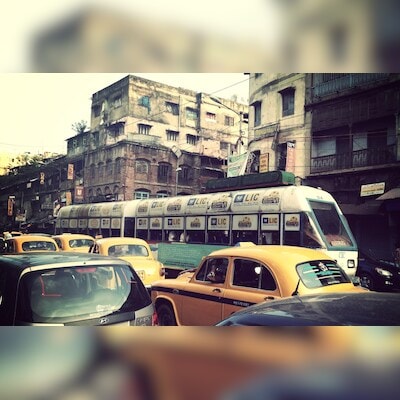Against a grey sky, the camera follows a trolley connecting a tram car with an overhead cable. The shot spans about two minutes as the opening credits roll for Mahanagar — one of Satyajit Ray’s masterpieces, part of a trilogy centred around the “Big City,” Kolkata.
For generations, filmmakers like Ray, Ritwik Ghatak, and Mrinal Sen have used trams as an iconic backdrop to evoke the essence of Kolkata, besides the Howrah Bridge and Victoria Memorial.
Click here to connect with us on WhatsApp
But now, if the state government has its way, this symbol of the city may soon exist only as a heritage piece.
The government’s stance comes amid ongoing PIL hearings in Calcutta High Court over the gradual discontinuation of tram services. As the city waits for a final verdict, the people of Kolkata have already taken the news to heart.
“What will remain of our pride?” asks filmmaker Goutam Ghose. “This is Asia’s first tramway — our heritage.”
People from Mumbai and the South come here to film trams, he says. “The Howrah Bridge, trams, and yellow taxis — these are Kolkata’s icons. Globally, trams are popular; we need to upgrade this system, not discard it,” Ghose adds.
On social media, nostalgia has surged, with netizens sharing reels and photos of trams, accompanied by taglines like, “Forever in our hearts”, and “Chilo, ache, thakbe (there was, is, and will be)”.
On Thursday, tram enthusiasts demonstrated at the Shyambazar tram depot, raising “Tram Bachao” slogans. This likely won’t be the last protest in a city known for its passion, and which recently witnessed public outcry over the brutal rape and murder of a junior doctor at RG Kar Medical College.
Yet, the government’s stance isn’t surprising. The ding-ding of Kolkata’s trams, now in their 151st year, has been fading for some time.
Debasish Bhattacharyya, president of the Calcutta Tram Users Association (CTUA), notes that when the Trinamool Congress came to power in 2011, there were 26 or 27 routes. That number fell to 14 by 2017-18, and reduced to five in 2020. Today, only three remain, with one route suspended due to ongoing underground water supply work.
Formed in 2016 to advocate for trams, the CTUA’s efforts coincide with growing global calls for sustainable, eco-friendly transport systems amid the climate crisis.
Pradeep Kakkar, founding member of the NGO People United for Better Living in Calcutta, says the transport system is being dismantled for commercial reasons.
The government wants the tram depots — valuable property — freed up, he says. “We filed a petition to stop the bitumenisation of tram tracks, which is the death knell for trams. Last year, the court ruled in our favour, but the state government is violating this order. We have now filed an application for contempt in court,” he adds.
GM Kapur, convenor of the Calcutta chapter of the Indian National Trust for Art and Cultural Heritage (Intach), is equally disappointed. Limiting tram services to one route undermines both heritage conservation and environmental efforts, he says. “Trams are the most sustainable, eco-friendly mode of transport.”
Nearly two decades ago, Intach had conceived and created a heritage tram route called Banalata with Calcutta Tramways Company and West Bengal tourism. It was named after poet Jibanananda Das’s iconic work, Banalata Sen. Das, ironically, had been fatally struck by a tram in 1954.
Kolkata introduced trams in 1873 — initially, as a horse-drawn service. Despite the advent of other public transport options, trams continued to run, albeit with a dwindling ridership. Now, their future hangs in the balance.
CTUA recently posted on X: “Over 450 cities globally run trams, and 70+ cities have brought them back after discontinuation. Cities with higher population density and fewer roads than Kolkata have reintroduced trams! Why can’t Kolkata?”
Strasbourg in France, for instance, rebuilt its 60-km tram network, which is over a century-old, after decades of decline. Other French cities followed suit. Sydney, after halting trams, reinstated the service at a cost of 2.9 billion Australian dollars to reduce congestion. Melbourne never gave up trams.
In India, Kolkata’s is the last surviving tram system — Mumbai stopped its tram service in 1964, Delhi in 1963, and Chennai in 1953.
“The tram is a living heritage, not a museum piece. It’s a solution to Kolkata’s environmental and traffic challenges,” says Mahadeb Shi, general secretary, CTUA.
First Published: Sep 27 2024 | 5:58 PM IST
